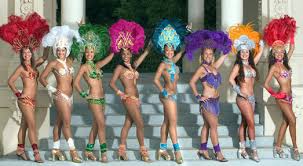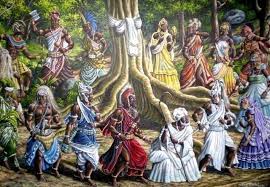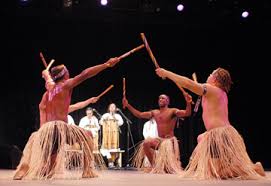Samba, is a Brazilian dance and musical genre derived from African and European roots. It is a worldwide recognized symbol of Brazil and the Carnival. Samba originates in African roots in Brazil and is the national standard of excellence in dance. Considered one of the most popular Brazilian cultural experiences, samba has become a symbol of national Brazilian identity. The Bahian samba de roda, which became a Heritage of Humanity of Unesco in 2005, was a basis of the samba carioca.

Although the samba exists throughout the country—especially in Bahia, Maranhão, Minas Gerais, snd São Paulo—in the form of various popular rhythms and dances that originated from the regional batuque, samba as gender is a musical expression of urban Rio de Janeiro, where in fact born and has developed between the end of 19th century and the first decades of 20th century. It was in Rio that dance practiced by slaves migrated Bahians came into contact and incorporated other genres played in the city (such as the polka, the maxixe, the lundu, the xote, among others), acquiring a completely unique character and creating the samba carioca urban and carnavalesco.

During the 1910s, some songs under the name of samba were recorded, but these recordings have not achieved great effect; however, in 1917, was recorded in disc "Pelo Telefone" ("By Phone"), which is considered the first samba. The song has the authority claimed by Ernesto dos Santos, best known as Donga, with co-authors attributed to Mauro de Almeida, a known carnaval columnist. Actually, "Pelo Telefone" was creating a collective of musicians who participated in the celebrations of the house Tia Ciata (Ciata aunt), but eventually registed by Donga and the Almeida National Library.
Forró is a kind of Northeastern Brazilian dance that developed from European classics styles os folk musics such as "Chula" and "Xotis" (term that originated the derivate "Xote"), as well as a word used to denote the different genres of music which accompanies the dance. Both are much in evidence during the annual Festa Junina (June Festival), a part of Brazilian traditional culture which celebrates some of the saints of the Catholic religion. The most celebrated day of the festival is known as the Saint John's (São João) day.
Origin of the term
The most accepted theory puts forró as a derivative of forrobodó, meaning "great party" or "commotion". This is the view held by Brazilian folklorist Câmara Cascudo, who studied the Brazilian Northeast through most of his life. Forrobodó is believed to come from the word forbodó (itself a corruption of fauxbourdon), which was used in the Portuguese court to define a dull party.
Another theory often heard popularly in Brazil is that the word forró is a derivative of the English expression "for all" and that it originated in the early 1900s. English engineers on the Great Western Railway of Brazil near Recife would throw balls on weekends and classify them as either only for railroad personnel or for the general populace ("for all"). This belief was somewhat reinforced by a similar practice by USAF personnel stationed at the Natal Air Force Base during World War II, but it is not possible because before the USAF went to Natal, the name "Forró" was already in use.
There is a third theory that it also comes from the number of the engine that the English engineers used as they roamed the tracks of the railroad supervising the construction, "40" or " Four-oh" that was corrupted by the Brazilians into "Forró".
Popularity
Forró is the most popular genre in Brazil's Northeast. It is the name of the dance. Different genres of music can be used to dance the forró. Traditionally, all of these music genres uses only three instruments (accordion, zabumba and a metal triangle). The dance also become very different as you cross the borders of the Northeast into the Southeast. As part of the popular culture it is in constant change. The dance known as college forró is the most common style between the middle-class students of colleges and universities in the Southeast, having influences of other dances like salsa and samba-rock. The traditional music used to dance the forró was brought to the Southeast from the Northeast by Luiz Gonzaga, who transformed the baião (a word originated from baiano and assigned a warm-up for artists to search for inspiration before playing) into a more sophisticated rhythm. In later years, forró achieved popularity throughout Brazil, in the form of a slower genre known as xote, that has been influenced by pop-rock music to become more acceptable by Brazilian youth of Southeast, South and Center-West.
>Brazweb.NetMusica no Perfil<
Axé music is a popular music genre originating in Salvador, Bahia, Brazil approximately in 1986, fusing different Afro-Caribbean genres, such as Marcha, Reggae, and Calypso. It also includes influences of Afro-Brasilian music such as Frevo, Forró and Carixada. The most important creator of this music style was Alfredo Moura, conducting Carlinhos Brown, Luiz Caldas, Sarajane and others. The word "axé" comes from a Yoruba religious greeting used in the Candomblé and Umbanda religions that means "soul", "light", "spirit" or "good vibration".
Origin of the term Axé
The term "axé" began as an insult, intended to point out the perceived pretentiousness of the genre. It was applied vaguely, however, and anything recorded in Salvador was soon nicknamed "axé".
Popularity
When Daniela Mercury released O Canto da Cidade in 1992, axé entered the mainstream pop music scene and became one of the most popular genres in Brazil. Two years before, the American and European release of Margareth Menezes' Elegibô took the style to international audiences.
Roots of Axé
The root of axé is in guitarra baiana, a 1950s guitar style that used electric guitars to play the frevo from Pernambuco. This genre was purely instrumental, and remained so until the 1970s, when Moraes Moreira (of the band Novos Baianos) went solo.
Carnival bands like Filhos de Gandhi, Olodum and Muzenza then fused the electric frevo with maracatu and Olodum rhythms, African ijexá and Caribbean merengue. Olodum's afro-music fusion was a Bahian success in the 1980s and was followed by deboche (debauchery), an electric frevo/ijexá fusion.
Axé in the 1990's
The release of O Canto da Cidade set the stage for artist and bands like Ivete Sangalo, Banda Cheiro de Amor, Banda Eva, Bandamel, Asa de Águia and Chiclete com Banana.
Though axé was very popular through the 1990s, it had famous detractors like Dorival Caymmi. On the other hand, Caetano Veloso supported it.

The year of 1995 saw one of the biggest commercial successes to come out of Salvador, Gera Samba (renamed É o Tchan), who pioneered a sexy image and crossover appeal, and was very criticized because of this.
Axé today
Currently, the biggest axé music stars are Ivete Sangalo and Cláudia Leitte.
Axé Bahia is a six-member eurodance/axé music group from Brazil, who achieved fame in South America with their single "Beijo na Boca", particularly the Spanish-language version, "Beso en la Boca".
Afro-Brazilian, African-Brazilian or Black Brazilian, is the term used to racially categorize Brazilian citizens who self-reported to be of black or brown (Pardo) skin colors to the official IBGE census. As of 2005, 91 million Brazilians were included in the black and brown category.

Brazil has the largest population of black origin outside of Africa with, in 2007, 7.4% classyfing themselves as preto (black skin color) and 42.3% as pardo (brown color). The latter classification is broad and encompasses Brazilians of mixed ancestry, including mulattos and caboclos making the total 49.5%.
The largest concentration of Afro-Brazilians is in the state of Bahia where over 80% of the people are descendants of Africans.
A large number of Brazilians have some African ancestry and Brazilian populations are remarkably heterogeneous. Due to intensive mixing with Europeans and Native Indians, Brazilians with African ancestors may or may not show any trace of black features

Who is Afro-Brazilian?
The Brazilian racial classification is based on self-classification. In the census, respondents choose their race or color in five categories: branca (white), parda (brown), preta (black), amarela (yellow) or indígena (indigenous). The idea that human beings can be divided in races first appeared in the 18th century and it became widespread in the 19th century through scientific racism. These ideas were based on belief in the existence and significance of racial categories, typically with a hierarchy of superior and inferior races. The concept of races was supported by many scientists, intellectuals and governments around the world. In the 20th century, with the development of human biology and genetics study, it was concluded that human races do not exist because the genetic differences between humans is nonexistent, making it impossible a subspecies division. Despite this, the concept of race is still alive in popular imagination, and it is still endorsed by several governments all around the world.
A majority of Brazilians are at least partly descended from African slaves, but they not necessarily demonstrate physical visible feature. According to a 2000 survey held in Rio de Janeiro, the entire self-reported Black population claimed to have African ancestry. Also, 86% of the self-reported Pardo (brown) and 38% of the self-reported White population reported to have African ancestors. It is notable that 14% of the Pardos (brown) from Rio de Janeiro said they have no African ancestors. This percentage may be even higher in Northern Brazil, where there was a greater ethnic contribution from Amerindian populations. However, African contribution was not absence in Northern Brazil, because there was a significant influx of African slaves to this region as well.
Racial classifications in Brazil are based on skin color and on other physical characteristics such as facial features, hair texture, etc. This is a poor indication of ancestry, because only a few genes are responsible for someone's skin color. This way, a person who "looks White" may have more African ancestry than a person who "looks Black", and vice-versa.
In Brazil, the racial divisions were never very clear, due to the high degree of miscegenation among Brazilians, making the concept of race weaker. Many Brazilians find it hard to define their own race. The 1976 Census found 136 different answers to the question about race. Some of the self-reported racial classifications were: honeyed white, tanned, cinnamon, chocolate, sarará, copper, sunburned, polished, kind black, fire pink, toasted, etc. These responses were interpreted by scholars and activists of the black movement as proof of Brazilian racism, where Blacks do not want to assume their identity, and hide themselves in euphemisms. From this idea, since the government of Fernando Henrique Cardoso, the Black Brazilian population is treated as the sum of the self-declared Blacks and Browns. This conception is based on the idea that Black Brazilians lie to the census and say they are Browns. Also, based on social indicators, in which Blacks and Browns appear disadvantaged when compared to Whites.
This binary division of Brazilians between Whites and Blacks (largely influenced by American one-drop rule) has received much criticism. Sociologist Demétrio Magnoli considers the sum of Blacks and Browns as Blacks an assault on the racial vision of the Brazilians. A survey about race replaced the word "Pardo" by "Moreno". Much of the Pardos choose the Moreno category, half of people who previously reported to be White then reported to be Moreno and also half of self-reported Blacks also choose the Moreno category. According to Magnoli, Brazilians choose the Portuguese word Moreno because it has different meanings in Brazil (it can mean Black, Brown or White person with dark hair). This way, many Brazilians do not see themselves as a member of a certain racial group, since the word Moreno is widely used by people of different skin colors. Then, the official figures count Afro-Brazilians as the union of self-reported Blacks and Browns. However, in Brazilian day life the conception of who is Afro-Brazilian is different from the officially adopted.
Maculelê (Pronounced: mah-koo-leh-LEH) is an Afro Brazilian dance and a martial art where a number of people gather in a circle called a roda.

Form
In the roda, one or more atabaques positioned at the entrance of the circle. Each person brandishes a pair of long sticks, traditionally made from biriba wood from Brazil. The sticks, called grimas, traditionally measure 24 inches long by 1 and 1/8 inch thick. As the Maculelê rhythm plays on the atabaque, the people in the circle begin rhythmically striking the sticks together. The leader sings, and the people in the circle respond by singing the chorus of the songs. When the leader gives the signal to begin playing Maculelê, two people enter the circle, and to the rhythm of the atabaque, they begin striking their own and each other's sticks together. On the first three beats, they strike their own sticks together, making expressive and athletic dance movements, and on each fourth beat, they strike each other's respective right-hand stick together. This makes for a dance that looks like "mock stick combat". (Also, traditionally in Maculelê, the players wear dried grass skirts).

Capoeira
In some capoeira schools, students perform maculelê using a pair of machetes (facão in Portuguese; plural: facões). These large knives are associated with the tools used by slaves in plantations. The sounds of the knives striking one another, and the showers of sparks that are formed, make this performance particularly impressive. Due to the danger of performing maculelê in this way, generally it is only practiced by graduated students and masters.
Origins
The origins of Maculelê are obscure, and there are many stories, theories and beliefs that claim "this is how Maculelê came to be". Here are three:
- During the slavery era in Brazil, the slaves in the sugarcane plantations would gather and play Maculelê as a game to vent their anger and frustration from being slaves. At this time, machetes were used instead of sticks. Sticks were later incorporated for safety reasons. However, some experts still use machetes.
- There were two tribes in Brazil: a peaceful tribe, and a warlike one. The warlike tribe would repeatedly attack the peaceful tribe, who had no way of defending themselves. One day, during an attack, a young boy named "Maculelê" picked up a pair of sticks and fought off the other tribe. The other tribe never attacked again. The boy didn't manage to fight them off completely, but did die trying. His home tribe then made a mock combat dance using sticks and named the dance "Maculelê" in his honor and memory.
- An interior West African village was embroiled in a regional conflict. All of the warriors of the village were called to the front lines to defend their people from invaders. All of the able bodied men gathered their arms and went to join the battle. The next day, the villagers were awakened to find their small village, supposedly far from the battle, was being attacked by part of the invading army. With no warriors left to defend the village, an unlikely hero emerged. A young boy took up two simple sticks and inspired the remaining villagers to mount a fearless defense. His heroic efforts became legend are represented in the Maculelê.
Maculelê is sometimes practiced by itself, but is quite often practiced alongside Capoeira, and is featured in many Capoeira performances. It should be noted that Maculelê and Capoeira are fairly similar in style.



